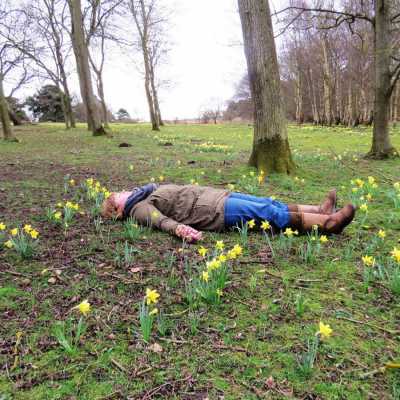http://www.witchesandpagans.com/sag...tradition-and-lore.html#.WqWdBEJxSPM.facebook

The Spring Equinox or vernal equinox occurs between 20 - 22 March. The word equinox is Latin for "equal night". It is also known as Ostara, Eostre or by its Welsh name, Alban Eiler, "the light on the earth". It is a time when day and night are of equal length, and the sun rises and sets due east and west respectively. In secular society, the spring equinox marks the first days of spring, but as we've seen above, Imbolc is actually when the first signs appear, at least in Britain.
The Christian holy day of Easter sometimes falls near this time, though it is a moveable feast with rather Pagan overtones (at least in the timing of it), for it falls on the first Sunday after the full moon following the spring equinox. Many are already aware of the symbols of this time of year, the rabbits and bunnies and eggs that abound, mostly in chocolate or sweetie form. Eggs and hares are common symbols in much of Western Paganism, and indeed our Celtic ancestors held hares in high regard, for it was unlawful to kill a hare, apart from at the Spring Equinox, when they could be killed and eaten to share in their blessings and fertility through sympathetic magic. [1] Hens might begin laying again at this time, after a period of dormancy over the winter. If there is insufficient light, many breeds lay less or not at all, and also may stop in very cold weather. With the return of the longer days and warmth from the sun, an increase in egg production would naturally occur, and would be celebrated. The Druid's Egg, attested to by the Roman writer Pliny, was said to be a ball of twisted snakes, however, many modern Druids hold that it was more likely to be an egg-shaped stone talisman carried and used by the Druids for magic and ritual. [2]
There are many Neolithic sites connected to both the Spring and Autumn Equinox. Perhaps the most famous of all is West Kennett Longbarrow, near Avebury stone circle and considered park of the Avebury complex which also includes Silbury Hill. The sun illuminates an inner chamber during the equinoxes, similar to Newgrange in Ireland during the Winter Solstice. At Silbury Hill, from a certain vantage point the sun actually rolls up the side of the hill and grows in size when it rises on the Spring Equinox. In Loughcrew, Ireland the illumination of the barrow is even more spectacular, for it only lights up specific symbols on the walls and must have taken a great deal of time and calculation to create such a precise phenomenon. Stonehenge also has an equinox alignment where the sun rises directly between two stones; one of many alignments.
Full story at site

The Spring Equinox or vernal equinox occurs between 20 - 22 March. The word equinox is Latin for "equal night". It is also known as Ostara, Eostre or by its Welsh name, Alban Eiler, "the light on the earth". It is a time when day and night are of equal length, and the sun rises and sets due east and west respectively. In secular society, the spring equinox marks the first days of spring, but as we've seen above, Imbolc is actually when the first signs appear, at least in Britain.
The Christian holy day of Easter sometimes falls near this time, though it is a moveable feast with rather Pagan overtones (at least in the timing of it), for it falls on the first Sunday after the full moon following the spring equinox. Many are already aware of the symbols of this time of year, the rabbits and bunnies and eggs that abound, mostly in chocolate or sweetie form. Eggs and hares are common symbols in much of Western Paganism, and indeed our Celtic ancestors held hares in high regard, for it was unlawful to kill a hare, apart from at the Spring Equinox, when they could be killed and eaten to share in their blessings and fertility through sympathetic magic. [1] Hens might begin laying again at this time, after a period of dormancy over the winter. If there is insufficient light, many breeds lay less or not at all, and also may stop in very cold weather. With the return of the longer days and warmth from the sun, an increase in egg production would naturally occur, and would be celebrated. The Druid's Egg, attested to by the Roman writer Pliny, was said to be a ball of twisted snakes, however, many modern Druids hold that it was more likely to be an egg-shaped stone talisman carried and used by the Druids for magic and ritual. [2]
There are many Neolithic sites connected to both the Spring and Autumn Equinox. Perhaps the most famous of all is West Kennett Longbarrow, near Avebury stone circle and considered park of the Avebury complex which also includes Silbury Hill. The sun illuminates an inner chamber during the equinoxes, similar to Newgrange in Ireland during the Winter Solstice. At Silbury Hill, from a certain vantage point the sun actually rolls up the side of the hill and grows in size when it rises on the Spring Equinox. In Loughcrew, Ireland the illumination of the barrow is even more spectacular, for it only lights up specific symbols on the walls and must have taken a great deal of time and calculation to create such a precise phenomenon. Stonehenge also has an equinox alignment where the sun rises directly between two stones; one of many alignments.
Full story at site
